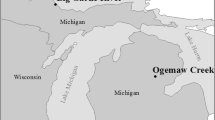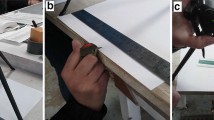Summary
The ages of 252 mature female krill, collected from Prydz Bay in January 1985, were determined using length frequency analysis and the fluorescent age pigment (FAP) technique. Results of both methods suggest 6 years classes for adult krill. Correspondence between the ages determined by the two techniques is generally within one year. The animals were also analyzed by a computerized image analysis system, which recorded a large suite of size and shape parameters. The accuracy of discriminant functions constructed to relate the image analysis parameters to age approached 90% for the ages defined by length frequency, and 52% for physiological age.
Similar content being viewed by others
References
Bhattacharya C (1967) A simple method of resolution of a distribution into Gaussian components. Biometrics 23:115–135
Cassie RM (1954) Some uses of probability paper in the analysis of size frequency distributions. Aust J Mar Freshw Res 5:513–552
Cosgriff RL (1960) Identification of shapes. Ohio State University Res Foundation, Rep 820-11, ASTIA AD 254, 729 pp
Ettershank G (1983) Age structure and cyclical annual size change in the Antarctic krill, Euphausia superba Dana. Polar Biol 2:189–193
Ettershank G (1984a) A new approach for assessing longevity in the Antarctic krill Euphausia superba Dana. J Crust Biol 4 (Spec No 1):295–305
Ettershank G (1984b) Methodology for age determination of Antarctic krill using the age pigment lipofuscin. BIOMASS Handbook no 26. Cambridge (UK), 14 pp
Hasselblad V (1969) Estimation of finite mixtures of distributions from the exponential family. J Am Stat Assoc 64:1459–1471
Hu MK (1962) Pattern recognition by moment invariants. Proc IRE Transsdact Inf Theory IT-8, pp 179–187
ICLARM (1987) The compleat ELEFAN International Center for Living Aquatic Resources Management. Makati, Metro Manila, Phillippines
Ikeda T (1985) Life history of Antarctic krill Euphausia superba: a new look from an experimental approach. Bull Mar Sci 37:313–318
Ikeda T, Dixon P (1982) Body shrinkage: a possible over0wintering strategy of the Antarctic krill (Euphausia superba Dana). J Exp Mar Biol Ecol 62:143–151
Ikeda T, Hosie G, Stolp M (1986) SIBEX II cruise krill/zooplankton data. ANARE Res Notes No 32, Antarctic Division Department of Science 70 pp
Ivanov BG (1970) On the biology of the Antarctic krill Euphausia superba. Mar Biol 7:340–351
Jeffries P, Berman M, Poularikas A, Katsinis C, Melas I, Sherman K, Bivins L (1984) Automated sizing, counting and identification of zooplankton by pattern recognition. Mar Biol 78:329–334
Macdonald PDM, Pitcher TJ (1979) Age-groups from size-frequency data: a versatile and efficient method of analyzing distribution mixtures. J Fish Res Board Can 36:987–1001
Mackintosh NA (1972) Life cycle of Antarctic krill in relation to ice and water conditions. Discovery Rep 36:1–94
Makarov RR, Denys CJ (1982) Stages of sexual maturity of Euphausia superba dana. BIOMASS Handbook No 11, 13 pp
Marr JWS (1962) The natural history and geography of the Antarctic krill (Euphausia supberba Dana). Discovery Rep 32:33–464
Mauchline J (1980) Measurement of body length of Euphausia superba Dana. BIOMASS Handbook No 4. Cambridge (UK), 9 pp
Nicol S (1987) Some limitations on the use of the lipofuscin ageing technique. Mar Biol 93:609–614
Rosenberg AA, Beddington JR, Basson M (1986) Growth and longevity of krill during the first decade of pelagic whaling. Nature 324:152–154
Ruud JT (1932) On the biology of Southern Euphausiidae. Hvalrad Skr 2:1–105
SAS Institute Inc (1985) SAS User's Guide: Statistics, Version 5 edn. Cary, NC 596 pp
Shevtsov VV, Makarov RR (1969) On the biology of the Antarctic krill (Russ). Tr Vses Nauchno-Issled Inst Morsk Rybn Khoz Okeanogr 66:177–206
Siegel V (1987) Age and growth of antarctic Euphausiacea (Crustacea) under natural conditions. Mar Biol 96:483–495
Steedman HF (1976) Zooplankton fixation and presevation. Monographs on oceanographic methodology, vol 4. UNESCO Press, Paris 350 pp
Wolfe JH (1971) A Monte Carlo study of the sampling distribution of the likelihood ratio for mixtures of multinominal distributions. Tech Bull STB 72-2, Nav Pers & Tran Res Lab, San Diego
Author information
Authors and Affiliations
Additional information
Communicated by R. Siegfried, Cape Town
Rights and permissions
About this article
Cite this article
Berman, M.S., McVey, A.L. & Ettershank, G. Age determination of Antarctic krill using fluorescence and image analysis of size. Polar Biol 9, 267–271 (1989). https://doi.org/10.1007/BF00263775
Received:
Accepted:
Issue Date:
DOI: https://doi.org/10.1007/BF00263775




